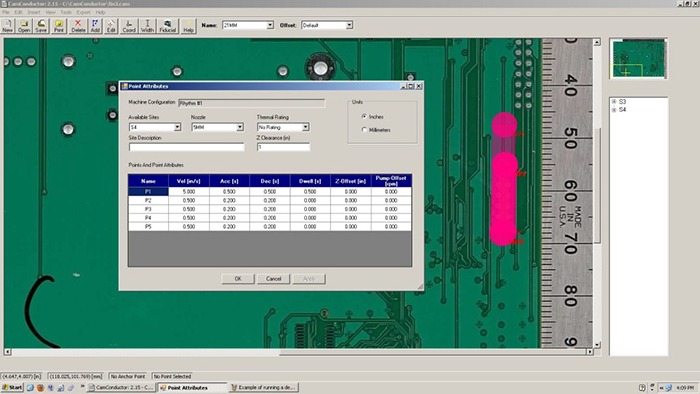Selective Soldering

A selective soldering machine can be used to fix misaligned parts.
OK, I confess. Sometimes we do make mistakes. As much as I hate to admit it, it does happen. For example, we’ve seen headers not fully seated to the board. They’re a little crooked, or one edge is touching the PCB, while the other edge is so far up in the air that you can’t even see the pin protruding through the other side of the board. Other times, an edge connector needs to protrude through a cover panel and there’s no room for play. The connector must be perfectly flat and perfectly square. If you find yourself in this situation, your selective soldering machine can be your best friend.
Warning! On some machines, you may be required to bypass security features. Please consult your manufacturer before bypassing anything designed to protect you from a dangerous machine.
If the connector is larger than the size of the nozzle, program the machine to “walk” back and forth over the pins of the connector (Figure 1). There’s a limit to how long a connector could reasonably be reworked using this method. We’ve been able to fix 2"-long connectors on four-layer boards. The key was to make sure the nozzle could dwell a little bit on the pins that were connected to ground.

Figure 1. A selective soldering machine can be programmed to move back and forth over the pins of a large connector.
Every connector is different. Some connectors will become damaged after much exposure to heat. The plastics are not designed to handle it. For these connectors, we find it’s best to remove the entire connector and insert a new one. Other connectors, however, hold up well under the heat, and you’ll be able to apply slight pressure with your hand to push them back through the board. Be careful, however, as in many cases, pushing the pins down will also push the solder down, and you’ll have no topside fillet.
Make sure to preheat the board. You don’t want to hit this cold board with a bunch of molten solder. The thermal shock could shorten the lifetime of the assembly. Make sure it’s nice and hot before you begin.
Chris Denney is chief technology officer at Worthington Assembly (worthingtonassembly.com); cdenney@worthingtonassembly.com.
Designed properly, it’s actually okay if your machine makes contact with surface mount components.
One of the beautiful things about selective soldering machines (vs. wave soldering machines) is that they are easy to route around surface mount components mounted on the bottom side of the board. But it’s not always that easy. For example, what happens when the board designer ran out of room and placed surface mount components next to the through-hole components?
Believe it or not, contact can safely be made with surface mount components, so long as only one side of the component is reflowed at a time. This requires that the design of the board has the surface mount components perpendicular to the plated through-holes.
As shown in Figure 1, the path of the nozzle crosses directly over nine surface mount components. The area where the nozzle makes contact with the component will reflow the solder paste deposit, but the opposite side of the component will remain solid and hold the component in place. This can make one a little nervous the first time they try it, but rest assured, that component will stay put.

It would be a good idea to alert the board designers to this. Many designers like to use every square centimeter of the board, and knowing they can put surface mount components very close to plated through-holes, so long as they are perpendicular to the holes, will certainly make them happy.
Chris Denney is CTO at Worthington Assembly Inc; cdenney@worthingtonassembly.com.
Press Releases
- Industry Leaders Koh Young, Fuji America, and Creative Electron Unite to Launch The SMT Future Experience
- NanoFlowX Announces Strategic Partnership with Bentec Ltd to Accelerate PCB Protection Innovation Across Europe and India
- Strong signal for the industry: productronica 2025 drives positive industry trend
- Sharpen Your ESD Skills: CE3S Announces Desco’s First ANSI/ESD S20.20 Training Series for 2026


